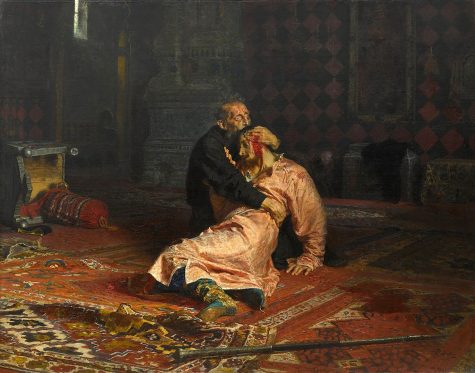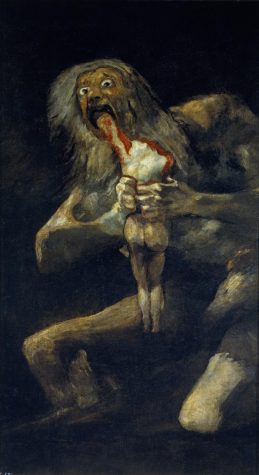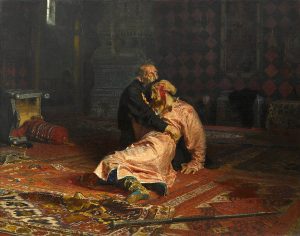Deep Meanings Behind Dark Art
March 10, 2023
There have been many artworks over the centuries that display strong themes of despair. At first glance, they’re dark, brutal, and depressing. However, once you delve into the stories behind them, you’ll see the underlying emotions behind the paintings. You start to humanize and even empathize with the characters from the paintings, seeing the deeper meanings within the art.
Ivan the Terrible and His Son Ivan

This painting is by Ilya Repin, a renowned Russian-Ukrainian realism artist. This piece was one of his most famous and controversial paintings. It depicts the Russian Tsar Ivan the Terrible holding his beloved son in his arms after he had dealt a fatal blow to his head out of anger. His expression shows deep anguish and remorse as the consequences of his actions sink in.
Although gruesome, the purpose of the artwork was to highlight the horror of violence and uncontrolled rage, which is something Ivan the Terrible suffered with as his mental health slowly deteriorated over time. The painting was shown in 1885 at the 12th Itinerant’s Society Exhibition in St. Petersburg, of which he was a member for many years. Its brutality and realism made the artwork controversial, as conservative and nationalist minds found it to be distasteful and “anti-Russian.”
The piece was no stranger to vandalism either. In 1913, the painting was slashed by a mentally ill iconographer, his motives unknown. The painting was attacked again in 2018, this time by a drunk man with a metal pole. It was said that he thought the piece was defaming the Tsar, framing him as more bloodthirsty than he actually was.
Saturn Devouring His Son

This piece was made by Goya, the most influential romanticist painter of his time. His work was known to have a sense of darkness and depravity the other artists lacked. This painting is unique in that it’s so grotesque and ugly, yet somehow captivating at the same time.
The painting features the Greek god Saturn devouring his son in a pretty graphic way. This is a depiction of the Greek myth of Saturn devouring his own children in fear of being overthrown by one of them, as a prophecy foretold. The way the artist depicts the god is also something to take note of. Saturn’s hair is gray and wild; his expression insinuates madness, consuming his son in a way that’s almost animalistic.
Goya painted this on his dining room wall in his home. Could you imagine eating breakfast in front of that? This art piece was one of the Black Paintings, or Pinturas Negras. They were a series of fourteen works painted by Goya at his villa outside Madrid, each delving into dark and disturbing themes.
Stańczyk

Painted by 19th-century Polish artist Jan Metjko, the central character of the painting is Stańczyk, a famous court jester during the Renaissance era in Poland. The jester is sitting in a dark room, slumped in a chair with his head bowed, appearing sad and deep in thought. The bright, red jester outfit draws an interesting contrast to the dark and gloomy atmosphere.
Unlike other jesters, Stańczyk was more than an entertainer. He was an intelligent man, using satire to comment on politics. Although his purpose was to entertain and humor others, he is portrayed as if something is troubling him deeply.
The full title of the painting, “Stańczyk during a ball at the court of Queen Bona in the face of the loss of Smolensk”, builds more depth by revealing the historical background—the war between Poland and Lithuania against Russia. One of its battles, the Siege of Smolensk, resulted in the Russians gaining control of the fortress. Smolensk was a trade hub for the Grand Duchy of Lithuania, the court of which Stańczyk served in, having a personal connection to it. On the table beside him, there is a discarded letter, possibly announcing the Russians invading Smolensk.
Stańczyk also became one of the earliest depictions of the sad clown paradox, a psychological phenomenon of entertainers humoring others, yet being unable to make themselves happy. In 1981, a series of psychological experiments were conducted on actors, especially comedians, and it was deduced that many of them used comedy as a coping mechanism for trauma.










